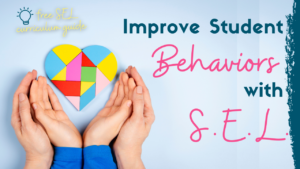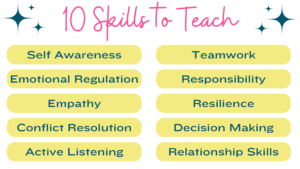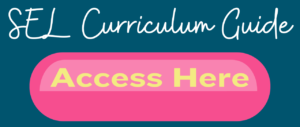
Manage Classroom Behavior Through SEL Instruction
We often think of the need to teach social and emotional learning (SEL) and manage classroom behavior as two different things. In all reality, teaching SEL is essential for improving classroom management and student behavior. When teachers consistently implement SEL into their instruction, they are being proactive in helping students manage their emotions and behavior.
Here’s a list of 10 SEL skills that will help you to manage classroom behavior less and build the classroom community of your dreams:
1. Self-Awareness: When students can identify and understand their own emotions, they are then able to better manage their reactions and behaviors in the classroom. You can support this by teaching into body cues for various emotions.
2. Emotion Regulation: It’s important to teach your students strategies for controlling their emotions. A few examples are breathing, going for a walk, or engaging in a quiet activity. When students begin to master this, it leads to fewer outbursts and disruptions during lessons. This means the teacher needs to manage classroom behavior less and is able to teach more.
3. Empathy: Encourage empathy by teaching your students to notice and respond to the feelings and perspectives of others. This will fostering a more compassionate and respectful classroom environment. The easiest way to implement this is through pausing for class discussions about the characters in the books you’re reading to the class.
4. Conflict Resolution: When students are given the strategies to resolve conflict independently, classroom disruptions are minimized. This leads to a more peaceful classroom atmosphere. It also gives teachers back the instructional time that typically give up to help solve student conflicts.
5. Active Listening: Teach active listening skills to improve communication and decrease misunderstandings between students. When thinking about this in regards to how to manage classroom behavior, it’s important to remember that active listening looks different from child to child. While one might be sitting calming on their bottom to listen, another might do their best listening rocking on a wobble stool or with a fidget.
6. Teamwork: Foster a sense of teamwork and collaboration to really ramp up your classroom community. When students feel supported by each other, it reduces incidents of isolation and disruptive behavior.
7. Responsibility: Hold students responsible for their own choices and actions. When this is done consistently, it leads to more accountable behavior and decision-making. Students begin to strive to be their best self.
8. Resilience & Persistence: Help students develop grit to keep going in the face of challenges. You can do this through teaching skills like being flexible, taking breaks and asking for support. When students understand these skills, it helps to reduce frustration and discouragement that can lead to disruptive behavior.
9. Decision-Making: Encourage thoughtful decision-making using strategies such as S.T.A.R. decision making. When students are able to tackle a problem with a strategy or plan, it empowers them to make better choices and avoid impulsive actions. This leads to less situations for the teacher to manage classroom behavior.
10. Relationship Skills: Create a classroom culture where all individuals are accepted and appreciated for who they are. You can cultivate these positive students-to-students and students-to-teacher relationships by bringing appreciation for the diversity in your classroom and in the world.

Teaching these SEL principles in your classroom can create a more conducive learning environment in which you don’t have to constantly manage classroom behavior. Instead, you’ve empowered your students with the skills and strategies to manage their own behavior both in the classroom and in their everyday lives.
Even more importantly, you’ve given your students the skills they need to be more successful academically, socially, and in life.
Not sure how to start? We’ve got you covered!
We’ve created a FREE SEL CURRICULUM GUIDE to get you started. It’s organized using the CASEL Framework. You’ll find the specific skills your students need to learn within: self-management, self-awareness, social awareness, relationship skills and responsible decision making.
Hopefully after teaching these SEL skills in your classroom, you’ll find you have to manage classroom behavior less.
Here are a couple lesson ideas to get you started:
Calming Corner for Kids | Free Printables
Create Respect in a Classroom – ANY Classroom!
Did you know Grace Over Grades members get UNLIMITED ACCESS to EVERY resource Grace Over Grades have ever made?


